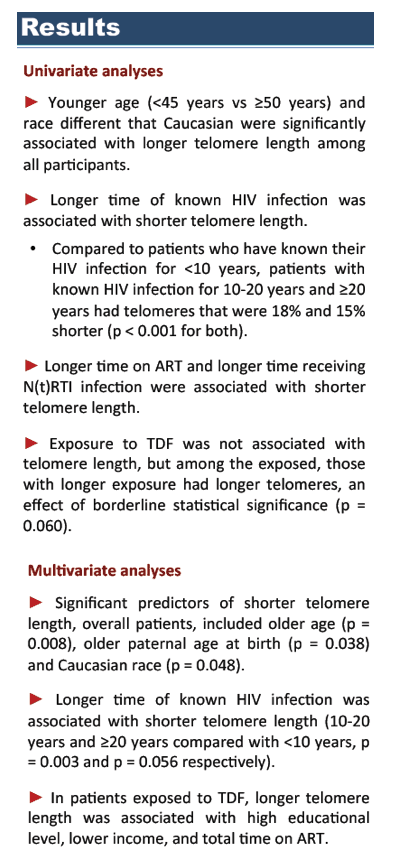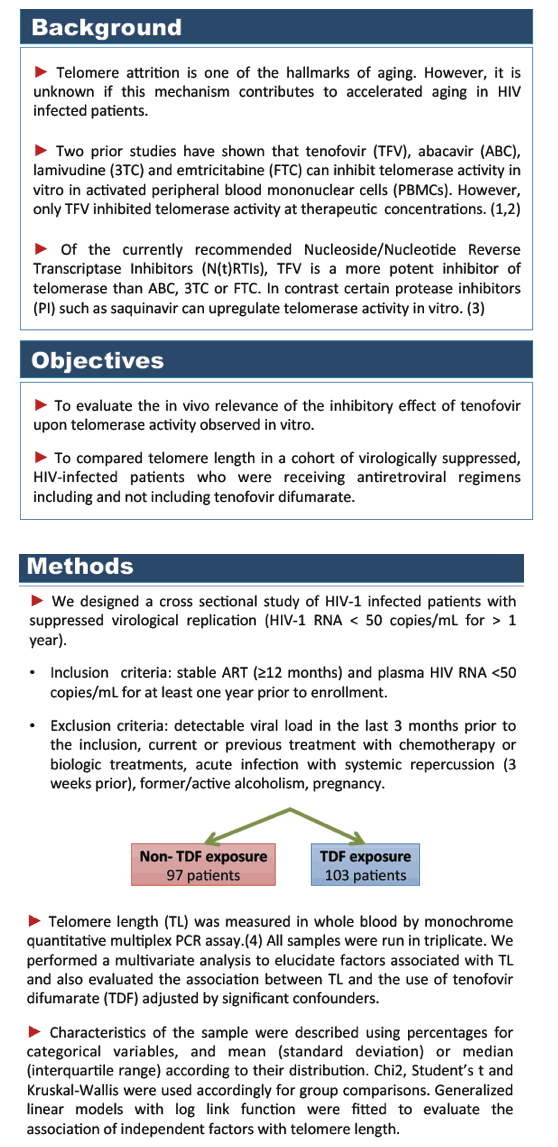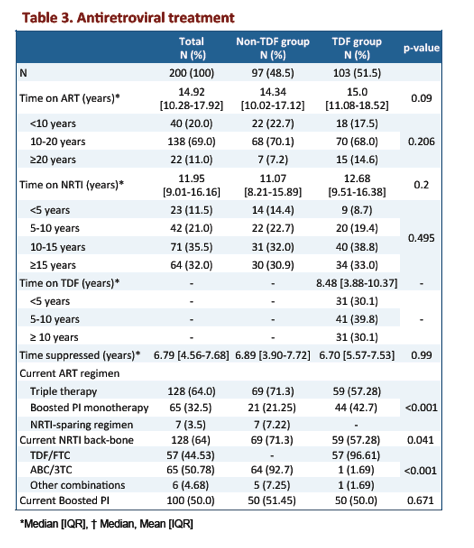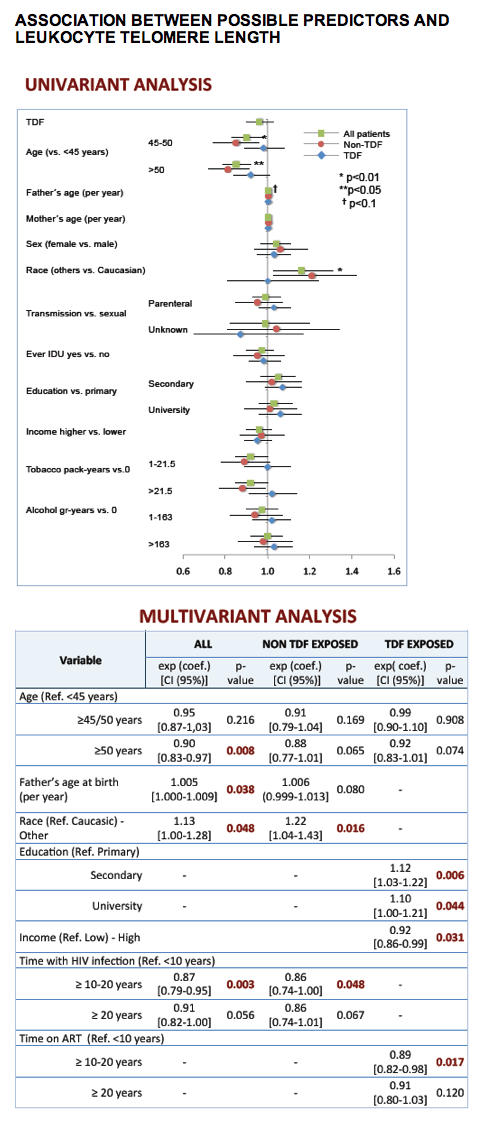 |
 |
 |
| |
Impact of antiretroviral treatment containing tenofovir difumarate on the telomere length of aviremic HIV-infected patients / NRTIs, HIV & Telomerase, Aging, Comorbidities
|
| |
| |
from Jules: the CROI report I just sent found shortly after HIV seroconversion telomerase is shortened. What is the effect on aging & comorbidities , further study might elucidate.
Reported by Jules Levin
CROI 2017 Feb 14-16 Seattle, WA
Rocio Montejano1, Natalia Stella-Ascariz1, Susana Monge2, Jose I. Bernardino1, Ignacio Perez-Valero1, Laura Pintado3, Marisa Montes1, Jesus Mingorance1, Rosario Perona3, Jose R. Arribas1
1Inst de Investigacion Hosp Univ La Paz, Madrid, Spain,2Univ de Alcala de Henares, Madrid, Spain,3Inst of Biomed Rsr 'Alberto Sols,' Madrid, Spain
--------------------------------
"The relationship between NRTI, reduced telomerase activity, and accelerated aging requires further investigation in HIV-infected individuals on cART.....Another potential cause of accelerated or accentuated aging in HIV-infected patientscould be telomere shortening caused by antiretroviral drugs"
Inhibition of Telomerase Activity by Human Immunodeficiency Virus (HIV) Nucleos(t)ide Reverse Transcriptase Inhibitors: A Potential Factor Contributing to HIV-Associated Accelerated Aging - (01/20/17)
"Telomerase activity (log-transformed) in HIV-infected patients (n = 36) was significantly decreased when compared with uninfected controls (n = 42) after adjusting for age (P = .011; Figure 3A).....Six of the 11 patients who had ceased NRTIs had matched samples available from when they were on NRTI and after 36-60 weeks off NRTI (but still on suppressive cART), but there were no significant differences in telomerase (Figure 3D) or TL (Figure 3E) when on and off NRTI......In a univariate analysis of all HIV-infected patients on NRTI (n = 39), TL was inversely associated with age (P = .009) and with duration of NRTI-containing cART (P = .01; Table 2). There were no significant associations between telomerase activity and any clinical parameters (Table 2). In a multivariate analysis for TL and telomerase, no parameter remained statistically significant.
.....The nucleos(t)ide reverse transcriptase inhibitors (NRTIs) zidovudine (AZT), didanosine (ddI), and abacavir (ABC) have been shown to inhibit telomerase activity in replicating cell lines in vitro, leading to accelerated shortening of TL [15-22]......The effects on telomerase activity and TL of the more commonly used NRTIs such as lamivudine (3TC), emtricitabine (FTC), and tenofovir disoproxil fumarate (TDF) have not been investigated......We also observed enhanced shortening of TL following incubation with 3TC, ABC, and TDF, consistent with inhibition of telomerase activity mediated by these NRTIs (Figure 1C). Again, TDF was the only NRTI tested that enhanced shortening of TL at therapeutic concentrations, which is in agreement with the potent inhibition of telomerase activity (Figure 1B). AZT and FTC did not enhance shortening of TL at all tested concentrations in PHA-activated PBMCs (Figure 1C)......We were surprised to demonstrate in vitro that FTC and 3TC inhibited telomerase activity only at high concentrations.....In summary, we have demonstrated that all NRTIs inhibit telomerase activity and TL in activated PBMC in vitro, with the greatest effect observed with TDF. Reduced telomerase activity was greatest in HIV-infected patients on NRTI-containing cART. An important future clinical question will be to determine whether any inhibition of telomerase by NRTIs in vivo is reversible following cessation of NRTI. The long-term effects in HIV-infected patients of NRTI exposure on telomerase activity, TL, and accelerated aging warrant further investigation.
We found that the duration of NRTI-containing cART was inversely associated with TL and that there was no association with telomerase activity. The association with duration of NRTI-containing cART demonstrated that for every year on NRTI-containing cART, there was a 0.036-unit reduction in TL, and for a 1-year increase in age, there was a 0.018-unit reduction in TL. However, in a multivariate analysis, both parameters were no longer statistically significantly related to TL. Potential explanations for this finding could include the small sample size or an interaction between these 2 parameters. The small sample size also did not allow us to take into account other factors that could potentially confound our findings, such as chronic immune activation, cytomegalovirus coinfection, cigarette smoking, levels of physical activity, and the use of statins and other ART drugs [7] [43-48]. Saquinavir has been demonstrated to upregulate telomerase activity in vitro [44, 45]. However, despite the possibility of saquinavir and therefore other PIs antagonizing NRTI-mediated telomerase inhibition in vivo, we still observed significantly lower telomerase activity in patients receiving NRTI-containing cART, suggesting that any upregulation of telomerase activity by PIs was not sufficient to overcome the inhibitory effect of NRTIs on telomerase activity."
Brief Report: Differential Effects of Tenofovir, Abacavir, Emtricitabine, and Darunavir on Telomerase Activity In Vitro- (12/09/16)
"There is growing concern about the issue of aging of HIV-infected patients. It is well established that HIV-infected patients have an increased risk for several "non-AIDS" complications (cardiovascular disease, malignancy, liver disease, kidney disease, bone disease, and neurocognitive decline)that are classically associated with the normal aging process......It is also unknown if this accentuated or accelerated aging [from Jules: its accelerated in general, not accentuated depending on the specific comorbidity] is caused by theproinflammatory state associated with even well-controlled HIV infection, traditional risk factors (such as smoking) that are more prevalent among HIV-infected people, or other still unknown causes.......Another potential cause of accelerated or accentuated aging in HIV-infected patientscould be telomere shortening caused by antiretroviral drugs.5There is a close association between shortened telomere length (TL) in peripheral blood mononuclear cells (PBMCs) and diseases of aging, including increased cardiovascular diseases and dementia.6,7
"In our study, we explored if N(t)RTIs could play a role in the aging process of HIV-infected patients by means of inhibition of telomerase activity and whether DRV could have a similar effect. We have found that TFV and ABC, but not FTC, produced a significant dose-dependent decrease of telomerase activity in PHA-activated PBMCs within the therapeutic concentration range in vivo. After 72 hours of treatment, telomerase inhibition caused by TFV was more than double the inhibition caused by ABC: 29% and 12%, respectively. The observed decrease in telomerase activity caused by TFV and ABC was not associated with a decrease in hTERT protein level, or a change in the expression ofhTERTgene or the other genes that code for the subunits of the telomerase/shelterin complexes. Furthermore, we have shown that DRV did not affect telomerase activity,hTERTgene expression, or hTERT protein levels."
----------------
from Jules: median time on ART was 14-15 years so these patients were likely exposed to old NRTIs, but this study did not analyze the effect of the old NRTIs on telomerase.






|
| |
|
 |
 |
|
|